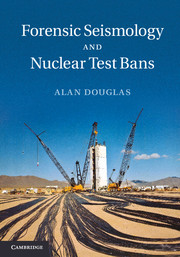Book contents
- Frontmatter
- Contents
- Preface
- Abbreviations and mathematical symbols
- Prologue
- 1 Seismology: ancient and modern
- 2 Statistical solutions to seismological problems
- 3 Seismograms as time series
- 4 Seismographs and seismograms
- 5 Seismometer arrays and processing methods
- 6 Seismogram interpretation and synthesis
- 7 Hypocentres and P travel times
- 8 Seismic magnitudes
- 9 Seismic source identification
- 10 Epilogue
- Appendix A P and S radiation from a double-couple source
- Appendix B Normal equations for analysis of variance
- Appendix C Some uses of the FFT
- Appendix D Anelastic attenuation
- Appendix E The relation of the transient and steady-state responses
- Appendix F Seismometer–galvanometer systems
- Appendix G SNI from summing array recordings
- Appendix H The equations for computing MP filters
- Appendix I Circular arrays
- Appendix J Geometrical spreading when S reflects as sP
- Appendix K The Fourier integral for a dispersed wave train
- Appendix L Tables of explosions and earthquakes
- Appendix M Album of body-wave seismograms
- Appendix N Exercises
- References
- Further reading
- Author index
- Index
9 - Seismic source identification
Published online by Cambridge University Press: 05 March 2013
- Frontmatter
- Contents
- Preface
- Abbreviations and mathematical symbols
- Prologue
- 1 Seismology: ancient and modern
- 2 Statistical solutions to seismological problems
- 3 Seismograms as time series
- 4 Seismographs and seismograms
- 5 Seismometer arrays and processing methods
- 6 Seismogram interpretation and synthesis
- 7 Hypocentres and P travel times
- 8 Seismic magnitudes
- 9 Seismic source identification
- 10 Epilogue
- Appendix A P and S radiation from a double-couple source
- Appendix B Normal equations for analysis of variance
- Appendix C Some uses of the FFT
- Appendix D Anelastic attenuation
- Appendix E The relation of the transient and steady-state responses
- Appendix F Seismometer–galvanometer systems
- Appendix G SNI from summing array recordings
- Appendix H The equations for computing MP filters
- Appendix I Circular arrays
- Appendix J Geometrical spreading when S reflects as sP
- Appendix K The Fourier integral for a dispersed wave train
- Appendix L Tables of explosions and earthquakes
- Appendix M Album of body-wave seismograms
- Appendix N Exercises
- References
- Further reading
- Author index
- Index
Summary
The data confirm that there is no basic difference between explosions and natural sources
M. A. Sadovskiy, O. K. Kedrov and I. P. Pasechnik FIZIKA ZEMLI, Istvestiy Akademii Nauk SSSR, USSR Academy of Sciences, 1986Introduction
Much of the history of forensic seismology has seen identification criteria introduced with claims that verification is solved, only to be followed by evidence that the claims were over optimistic and that exceptions have been found. Before AWE Blacknest discovered the advantages of deconvolving SP P seismograms, including correcting for attenuation, an analysis procedure was devised to collect statistics on the effectiveness of what then seemed to be the most promising criteria – first motion, spectral ratios and complexity – using initially only the array seismograms. Later the measurement of Ms at stations of the WWSSN was included so that the effectiveness of the mb:Ms criterion could be evaluated. This chapter describes the procedure used for the collection of identification statistics, and then goes on to look in detail at the identification criteria that have proved to be the most useful.
Routine processing and analysis
By 1964 AWE Blacknest had settled on a standard procedure for the analysis of the array seismograms. For each P signal an eight-channel output, such as that shown in Figure 9.1, is produced; the channels are listed in Table 9.1. Channel 2, the DS, is the most important channel, from which onsets and amplitudes are ideally read.
- Type
- Chapter
- Information
- Forensic Seismology and Nuclear Test Bans , pp. 340 - 371Publisher: Cambridge University PressPrint publication year: 2013
- 1
- Cited by



